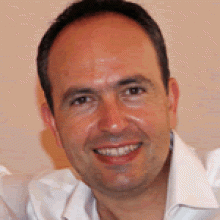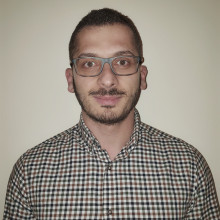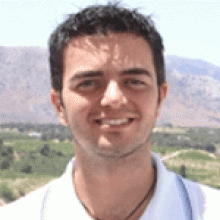Funding

Funding


Areti is author and co-author of > 15 peer-reviewed journal and conference papers, matching > 800 citations (h-index is 10). Well versed in EU regulations and procedures, EC funded projects, managing R&D projects, participated in several FP7 projects and WP leader in two H2020 projects. She has been the recipient of several scholarships and awards; in 2019 she has been awarded with a Post-doctoral 'Stavros Niarchos Foundation - FORTH Fellowship' within the project ARCHERS. As a Tech Expert, she currently works as a Technology Transfer Consultant in PRAXI Network/FORTH that is the leading technology transfer and innovation support organization in Greece; where recenty she has been promoted as Head of Unit at the Technology Transfer Office (TTO) at FORTH | PRAXI Network.
Education
- 2013, Ph.D. in Laser Physics, Dept. of Physics and Astronomy, University of St. Andrews, Scotland, UK.
- 2009, M.Sc. in Microelectronics & Optoelectronics, Dept. of Physics, University of Crete, Greece.
- 2007, B.Sc. in Physics, Dept. of Physics, University of Crete, Greece.
Career
- 01/2023 - ..., Head of Unit, Technology Transfer Office (TTO) at Foundation for Research and Technology - Hellas (FORTH) | PRAXI Network
- 09/2021 - 12/2022, Technology Transfer Consultant, PRAXI network
- 01/2021 - 12/2021, Postdoctoral Research Fellow, Department of Electrical & Computer Engineering, Hellenic Mediterranean University, (Heraklion, Greece)
- 07/2018 – 12/2020, Postdoctoral Research Fellow, Institute of Electronic Structure and Laser, Foundation of Research and Technology-Hellas, (Heraklion, Greece)
- 10/2018 – 12/18, Temporary Postdoctoral Research Associate in Science Program, Texas A&M University at Qatar -TAMUQ (Doha, Qatar)
- 12/14 – 06/18, Research & Development (R&D) Scientist in Nanoscribe GmbH (Karlsruhe, Germany)
- 12/13 – 11/14, Postdoctoral Researcher, Marie Curie Fellow & Laser Development Engineer at Amplitude Systèmes (Bordeaux, France)
- 12/12 – 11/13, Postdoctoral Research Assistant, Dept. of Physics and Astronomy, University of St. Andrews (Scotland, UK)
Interests
- Novel ultrafast laser micro/nano processing techniques
- Optoelectronics Engineering, Laser methods for biomolecules patterning and materials processing
- Light – Matter Interaction, 3D Printing
- 4D Printing and Soft Robotics, 3D Bioprinting
- Laser beam shaping / Adaptive Optics
- Non-linear lithography / Laser-based nanofabrication
Awards/Prizes/Distinctions
- 2022 - Guest Editor of Special Issue in Sensors: Women’s Special Issue Series - LINK:https://www.mdpi.com/journal/sensors/special_issues/WoS
- 2022 - Continues as a Vice chair @Marie Curie Alumni Association (MCAA) Greek Chapter
- 2021 - Dr. Mourka was selected again to serve as an evaluator by the European Commission
- 2021 - Vice chair @Marie Curie Alumni Association (MCAA) Greek Chapter
- 2021 - Women in Optics Planner | SPIE | https://spie.org/about-spie/advocacy/women-in-optics/women-in-optics-planner/2021-wio-planner/areti-mourka
- 2019 - Modular photo-induced non-linear additive manufacturing series - ‘MINOAS’ project | SNF-ARCHERS-IESL | https://archers.iesl.forth.gr/areti-mourka/
- 2019 - Best poster presentation | 12th FORTH Retreat (14th – 16th October 2019)
- 2019 - A travel grant was awarded from Marie Curie Alumni Association - MCAA for Areti's participation in the Forces and Forms of Doctoral Education 2019 conference in Hannover, Germany (5th – 6th September 2019)
- 2019 - Dr. Mourka was selected to serve as an evaluator by the European Commission
- 2018 - Visiting lecturer at the Department of Electronic Engineering of the Technological Educational Institute of Crete, in the context of the national program ‘Acquisition of Academic teaching experience in Young Scientists 2018-2019’
- 2013 - SUPA (Scottish Universities Physics Alliance) Graduate School Management Committee has supported Areti as an Early Career Researcher
- 2013 - Selected as a chairperson of the session on Laser Beam shaping at the Photonics 4 Life Network, 2nd Fast-Dot Summer School ‘Photonics meets Biology’, Heraklion, Greece (30th September – 3rd October 2013)
- 2013 - Best student poster presentation award at the Photonics 4 Life Network, 2nd Fast-Dot Summer School ‘Photonics meets Biology’, Heraklion, Greece, 30th September – 3rd October 2013 (100€ prize funded by Nature Photonics journal)
- 2011 - Photonics 4 Life Network, 1st Fast-Dot Summer School ‘Photonics meets Biology’, Heraklion, Greece, 15th - 18th September 2011. A scholarship was awarded from the organization committee to cover the cost of Areti's participation.
- 2009-2013 PhD funding from UK EPSRC (Engineering and Physical Sciences Research Council)
- 2007-2009 Microelectronics – Optoelectronics M. Sc. Graduate Program, EPEAEK, National Scholarship Foundation
- 2006-2007 Student Award, State Scholarships Foundation (IKY)
Other
Projects:
- CARIOQA-PMP project - HORIZON-CL4-2021-SPACE | 2022 - 2026
- AccelerACTION project - HORIZON-EIE-2021-SCALEUP | 2022 - 2025
- smartHEALTH project - European Digital Innovation Haubs (DIGITAL-2021-EDIH-INITIAL-01) | 2022 - 2026
- Alternative smart ocular implants with controlled ophthalmic pharmacokinetics 2018-2021 | https://eeeeof.iesl.forth.gr
- Functional surface treatments using ultra-short pulse laser system - FemtoSurf | H2020-ICT | https://cordis.europa.eu/project/id/825512
- High-Power Ultrafast LaSErs using Tapered Double-Clad Fibre - PULSE | H2020-ICT | https://cordis.europa.eu/project/id/824996
- Modular photo-induced non-linear additive manufacturing series - MINOAS | SNF-ARCHERS-IESL 2019
- PRINTOPTICS - Federal Ministry of Education and Research - BMBF (Bundesministerium für Bildung und Forschung) 2017
- PHOIBOS - Federal Ministry of Education and Research - BMBF (Bundesministerium für Bildung und Forschung) 2015
- Two Photon Absorbers for Biomedical Applications - TOPBIO | FP7-PEOPLE-2010-ITN | https://cordis.europa.eu/project/id/264362
Position Description
Νέα προθεσμία υποβολής υποψηφιοτήτων (ΔΙΔΑΔ/Φ.18.31/2361/οικ.22433)
Ανάπτυξη πειραματικών διατάξεων για την παραγωγή ισχυρής κυκλικά πολωμένης ακτινοβολίας υπεριωδούς κενού και στην εφαρμογή αυτής.
Για το πλήρες κείμενο της πρόσκλησης ακολουθήστε τον σύνδεσμο ‘Related Documents’, αριστερά
Required Qualifications
• Βαθμός πτυχίου Φυσικού ή Μηχανικού
• Μάστερ σε συναφές αντικείμενο
Desirable Qualifications
• Γνώση υπολογιστικών γλωσσών όπως Mathematica, Python κ.λπ.
• Καλή γνώση της αγγλικής γλώσσας
Application Procedure
Στο φάκελο υποβολής της πρότασης θα πρέπει να εμπεριέχονται τα ακόλουθα:
- Αίτηση (Form Greek) με αναφορά στον κωδικό της θέσης και στο όνομα του προγράμματος
- Αναλυτικό Βιογραφικό Σημείωμα
- Ευκρινή φωτοαντίγραφα τίτλων σπουδών
- Βεβαίωση σπουδών υποψήφιου διδάκτορα (θα πρέπει να προσκομισθεί πριν την έναρξη της σύμβασης)
Appointment Duration
36Position Description
Στο πλαίσιο της υλοποίησης της Πράξης «Εθνική Υποδομή Νανοτεχνολογίας, Προηγμένων Υλικών και Μικρο-/ Νανοηλεκτρονικής - INNOVATION-EL» με κωδικό ΟΠΣ 5002772, η οποία έχει ενταχθεί στη Δράση «Ενισχυση Των Υποδομων Έρευνας Και Καινοτομιας» του Επιχειρησιακού Προγράμματος Επιχειρηματικότητα Ανταγωνιστικότητα και Καινοτομία (ΕΠΑνΕΚ) που χρηματοδοτείται από την ΣΑΕ1451 με κωδικό πράξης ΣΑ (κωδικός ενάριθμου) 2017ΣΕ14510038 και συγχρηματοδοτείται από το Ευρωπαϊκό Ταμείο Περιφερειακής Ανάπτυξης (ΕΤΠΑ), το Ινστιτούτο Ηλεκτρονικής Δομής και Λέιζερ του Ιδρύματος Τεχνολογίας και Έρευνας (ΙΗΔΛ-ΙΤΕ) προτίθεται να απασχολήσει έκτακτο προσωπικό, με το οποίο θα συναφθούν συμβάσεις εργασίας ορισμένου χρόνου ή μίσθωσης έργου ή υποτροφίες ερευνητών-μεταπτυχιακών φοιτητών και προσκαλεί φυσικά πρόσωπα να εκδηλώσουν το ενδιαφέρον τους για την ανάληψη των σχετικών έργων, σύμφωνα με τους όρους που αναφέρονται στη συνέχεια της παρούσας πρόσκλησης.
Στο πλαίσιο της παρούσας Πρόσκλησης προκηρύσσεται μία (1) θέση έκτακτου προσωπικού που θα απασχοληθεί στο ΙΗΔΛ-ΙΤΕ μέσω σύναψης σύμβασης εργασίας ορισμένου χρόνου ή σύμβασης μίσθωσης έργου ή υποτροφίες ερευνητών-μεταπτυχιακών φοιτητών, στην οποία θα προσδιορίζεται η αποκλειστική απασχόληση στην Πράξη. Με ειδικότητα διαχίρειση έργου
Required Qualifications
• Πτυχίο Θετικών επιστημών
• Τουλάχιστον 5ετή εμπειρία σε:
- Παρακολούθηση δαπανών
- Διοργάνωση επιστημονικών σεμιναρίων, ημερίδων κ.λπ.
• Καλή γνώση της Αγγλικής γλώσσας
• Γνώση χειρισμού Η/Υ
Desirable Qualifications
• Εμπειρία στην υλοποίηση χρηματοδοτούμενων προγραμμάτων
Application Procedure
In order to be considered, the application must include:
- Completed application Form (Download link to the left)
- Brief CV
- Scanned copies of academic titles
- Reference letters (if required)
- All required forms and documents as layed out in each Job opening description
Please send your application and all documents to: hr@iesl.forth.gr and cc the Scientific supervisor marked in the left column






